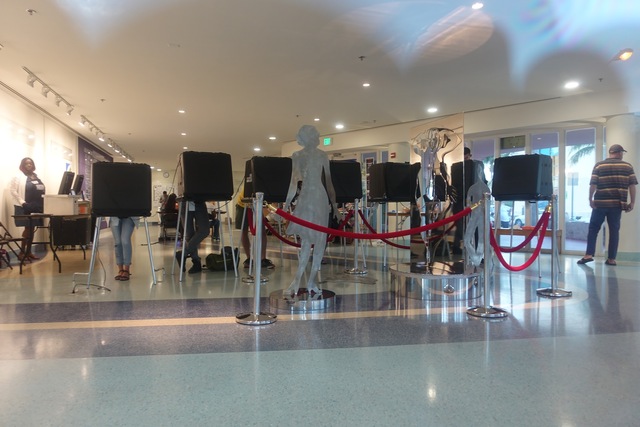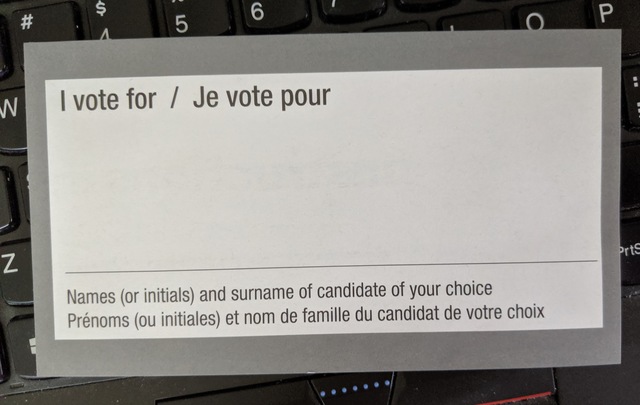Fix the coming US election peril by splitting complex ballots to allow Canadian style voting, spending more and letting people wait in virtual lines.

Covid-19 is going to create a massive crisis in the U.S. voting systems as many people fear. Fear of poling places has called for a switch to vote-by-mail. That's a good answer, but the problem is many states are simply not used to having most of their election take place by mail. Early examples demonstrate that while experienced locations (like Oregon) can do vote-by-mail well, inexperienced jurisdictions are likely to have major problems, and there is no way to create instant experience.
The issue has also become political. Different groups of people are more and less likely to vote under different voting systems. Politicians support systems that more of their voters will use, oppose ones that will be popular with people who vote otherwise. Donald Trump has even gone so far as to support vote by mail in states where it will help him while simultaneously fighting it in places where it may not.
If the President can use FUD on a system as well established as vote-by-mail, other new systems are in even more trouble. There are major problems with electronic voting systems (in person and especially remote) but it doesn't even matter if the problems are real. If fear can be raised, and the fear is slightly credible, the system can be attacked, the integrity of the election can be called into question or even disputed.
Many are afraid, with good reason, that November will involve mistakes, confusion and major delays. In many jurisdictions, mail-in votes are counted very slowly, after the election, with haste only needed if the margin is slim enough that the mail in votes could make a difference, which they often can't. Now, they will be the deciding factor, and may take weeks for accurate counting. Consider how in a recent New York Primary, 20% of mail in ballots were rejected.
Computer scientists and security experts are near-universal in our dislike for voting machines of any kind, other than optical counting machines which assist in counting voter readable ballots, and maybe assistance machines which help make those ballots but whose paper result is verified by the voter. So mail-in paper ballots are the main anti-Covid plan.
Here I propose a number of steps which could beef up the known and trusted voting methods to handle the virus problem:
- Just spend money to increase capacity and make polling places safer, faster and with fewer lines. Make use of buildings and furniture vacated by Covid.
- Allow voters to split ballots into two halves, one for fast counting, the other for slowing counting. Do the fast ballot on election day, leave the slower ballot along with it or mail it.
- Allow appointments at voting stations, or let people queue virtually rather than physically for their chance to vote.
Spend Money
A solution not getting too much consideration, because it would cost money, is to make paper polling-place voting fast, easy and safe. To spend the money to make this so, even if it means a lot of money.
One could start by just having lots more polling places. Lots more. So many that there are no lines and no crowds. Develop some touchless protocols for handing out or collecting ballots. Provide sanitizing wipes to every voter to use to clear their voting table. If weather permits, have outdoor voting tables. Get very large spaces (all those unused school gyms and closed buildings during the lockdown could be made available) and put in better ventilation, including things as simple as $50 box fans with HEPA or MERV-13 furnace filters if nothing else is available -- they work. Get lots more volunteers but space them apart.
I say voting tables because I propose a radical splitting of the ballot. In Canada, our big elections are extremely simple as there is only one choice on your ballot -- who your MP will be. You are handed a slip of paper, and you go to a table and write one X on it, and then the watch as you stick it in a box. That's it. It's super fast. Lines are quite rare in Canada.
At 8pm, they pull out the ballot box. Under the eyes of scrutineers from all parties, people count the paper ballots. In each polling place, it takes no more than 15 minutes. They can count them several times. They report the number back to the main returning office which adds them up. This also is very fast.
US elections are different. There can be dozens of choices on the ballot. This is one reason they have complex voting machines to both help you vote and make it easier to count. But it takes time and cost, so you get long lines. (Canada also assures you get at least 4 hours off during voting, to smooth out crowds.)
Hybrid Voting

To let the US vote faster, states not ready for mail-in voting can identify certain races as key races. Some fair procedure would be used to identify a very small number of key races. Likely choices would be President, Senator and member of congress, but possibly also Governor. Maybe just President, as it is the race which has established deadlines for counting and certifying the votes by the "first Monday after the second Wednesday in December."
Voters who wished it would, as now, receive a mail-in ballot. However, to vote, they would fill out most (or all) of the ballot at home, then bring it to a polling place.
At the polling place they would request a "polling day" ballot. This would be a simple one-page paper ballot with just the key races on it. They would go to a virus-safe voting station and fill in this ballot. They would bring it to the ballot box. There, in the presence of an official, they would punch a hole in their mail-in ballot to indicate they used the day ballot. They would place that marked ballot in a box of other mail-in ballots. They would place their day ballot in the day ballot box and leave.
At close of polls, the day ballots would be quickly counted. In addition, mail in ballots in the special box would be counted, but choices that were on the day ballot would be disregarded. Since mail in ballots are placed in nested envelopes, the punched hole would mark the internal ballot, as well as its envelopes, as paired with a day ballot. This would require the inner ballot be placed correctly in the envelopes, however, ballot design would account for it being placed in any of the possible orientations by leaving a blank area for the hole punch in all 4 areas, or perhaps having the punch-hole in the center. The hole would be large, and the system tested to make it robust.
Effort would be made to count these ballots as quickly as possible, and of course mail-in ballots could still be received by mail and thus counted quickly, ideally by optical counting machines.
A polling station is now much simpler. Tables, boxes and the hole punch. Not only could you put them in lots of places, including outdoors, they could also be put in trucks that drive the streets, playing music like an ice-cream truck. The trucks could also move from place to place, keeping hours. There could be stations with reservations to avoid lines.
Voters could, of course, also just vote as now, filling out their full ballot at the polling place, using machines that are there. This may however involve more virus risk than they like. And of course, they could mail their ballot from home. If they mail early, so there is no chance the virus could remain in the ballot, poll workers can quickly count those at the close of voting without fear. However, it would also be possible to put ballots in an oven at 160 degrees for a short time if they are designed to handle that without issue.
Wait at home
Another way to avoid lines is to let people queue up virtually, online. To do this, you request a place in line using a phone or computer. You are given a position in a virtual line, and you are able to monitor its progress. Based on the estimated time it will take you to get to the polling station (including a roaming one) you will get a signal when it's time to leave for the polling station. You should get there a couple of minutes early and wait outside or in your car. As your time comes up, you could then go to the entrance to the polling station, and show your code for immediate entry. If you miss your entry by more than a short grace period, then you either have to queue up again, or possibly now must physically queue.
Those without phones would have to take a physical queue number, like you do at the butcher's. Physical "take a number" tags would be mixed into line with virtual positions, but you would only see your position on a screen, not on your phone. There is some question of whether this easier system would impede those without phones.
Note that by "phone" it could mean a landline. Enter your travel time or location, and you would get a code number to write down, an estimate of the time, and a promise to be phoned back when it's time to head to the polls. People could also get appointments within given time windows that are convenient for them and their work schedule.
Securing the day ballot
It is key, of course, that people not be able to cast both a day ballot and a mail-in/hand-in ballot which might get double counted in those races. Even with the complicity of a polling station official. Some approaches include:
- Hole punch or other clear physical marking as described above, plus ballots are watched going in special bin.
- Special different envelope for hand-in ballots to further improve clarity.
- Require voters to pick their method in advance. They either get an all-mail-in ballot or a physically different mail-in ballot without the races on the day ballot.
- Make a ballot where your day ballot is part of it, but it detaches and can't easily be forged. The detached section is your day ballot.
We also want to be sure you can't just do the day ballot without pressure to send in a mail-in ballot on other races, to avoid having people only do the big races and thus alter turnout on the downballot. Of course, people could still send in blank downballots, but you still want the message to be that you vote the whole ballot. The removable part might help with that.








Add new comment